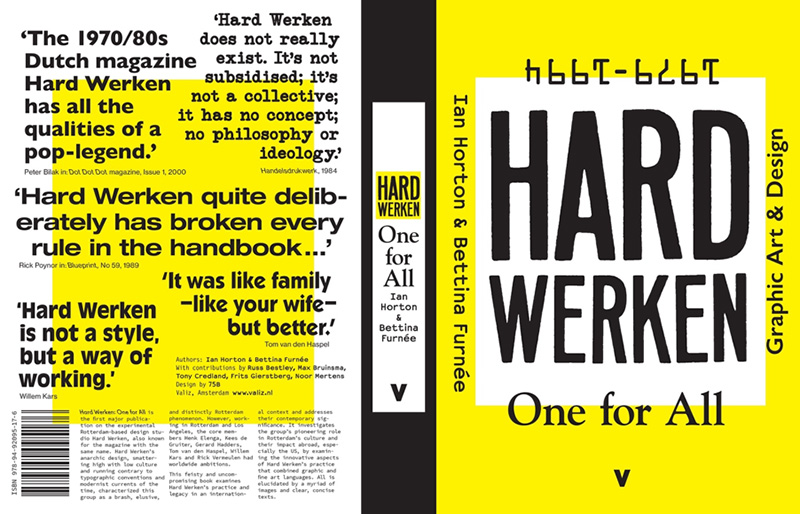by Gill Brown, PhD research student, LCC (School of Design)
Book cover design for Hard Werken: One for All – Graphic Art & Design 1979 – 1994
‘Artists who made design’ is how the founding members of the Rotterdam-based Hard Werken design studio described themselves, and from the outset their work was multidisciplinary, moving fluidly between art and design and epitomising the idea of the designer as author. This was the theme of a symposium held at LCC to mark the launch of the book Hard Werken: One for All – Graphic Art & Design 1979 – 1994, co-written by Ian Horton, Reader in Graphic Communication at LCC, and Dutch artist Bettina Furnée.
The book celebrates Hard Werken and their astonishingly varied output, that ranged from magazines and book covers to staged photography and furniture design. Perhaps most striking are ten issues of the large-format Hard Werken magazine. The cover spread of each issue was an autonomous artwork, unrelated to the content of the magazine. Advertisements were created solely by Hard Werken, with the advertisers themselves having no say in how their products were depicted. Illustrations and photographs from the magazine were repurposed to be shown in exhibitions and presented as works of art in their own right. Tony Credland, Lead Tutor for MA Graphic Design at LCC, had brought along to the symposium his personal copies of the magazine, to be handled with care!
The Hard Werken magazine had been one of the inspirations behind Tony’s own experience as designer author, co-creating, with Glenn Orton, the Cactus Network publication in 1989. Adopting the methods of mail art, they gathered submissions from their student friends across Europe to produce the first issue of Cactus; less a magazine, more a compilation of printed material, created to a broad brief. Tony and Glenn saw Cactus as a political project, reflecting their views, and did not edit or censor any of the material sent to them. With each issue, the number of submissions grew, and the amount of work required to compile an issue of Cactus grew with it. Screen-printing posters and handcrafting packaging was a labour-intensive, costly process and the sixteenth issue was compiled but never despatched.
The methods utilised in the production of Cactus were raised in the symposium’s panel discussion. The first question posed was, ‘does graphic authorship still have a role to play in the practice of contemporary graphic designers?’, and self-initiated, self-published projects, such as Cactus Network, were regarded as key to enabling graphic authorship. James Land, a final year student on the BA Graphic and Media Design, pointed out that during a BA you are in control of your work, but that does not prepare you for life as a commercial graphic designer, where you are working to a brief. James saw self-initiated work as the only way to gain authorship.
JP Hartnett, lecturer in contextual and theoretical studies at LCC, commented that self-publishing no longer seems radical as it is so easy to do, especially when compared to the hard work required to produce Cactus. By using social media to self-publish, is a designer sacrificing their independence and authorship to Instagram and Tumblr? Social media is controlled by relatively few corporations, so work is very commodified, whereas physical objects, like the Hard Werken magazine, can have an emotional effect on a viewer. An audience member, however, cautioned against the fetishisation of old technology. Craig Burston, course leader of BA Graphic and Media Design, pointed out that graphic design is traditionally seen as the subservient communicator of other people’s messages, so perhaps the concept of the designer as author (as described by Michael Rock in 1996) is a kick against that.
 A second question, ‘are designers entrepreneurial?’, provoked much discussion on the meaning of the word entrepreneurial, with Craig asking whether it is synonymous with being employable, while JP suggested that type design seems an obvious example of commercial entrepreneurship. Perhaps an audience member provided the most apt definition, describing entrepreneurship as equivalent to creative speculation and stating that authorship is what, as a designer, earns you money.
A second question, ‘are designers entrepreneurial?’, provoked much discussion on the meaning of the word entrepreneurial, with Craig asking whether it is synonymous with being employable, while JP suggested that type design seems an obvious example of commercial entrepreneurship. Perhaps an audience member provided the most apt definition, describing entrepreneurship as equivalent to creative speculation and stating that authorship is what, as a designer, earns you money.
Sadly, lack of time prevented further questions, but the presentations by Bettina, Ian and Tony had certainly provoked interest and debate amongst the audience. The highlighting of the work of Hard Werken, that Ian and Bettina’s book provides, may well prove an inspiration to future designer authors.


